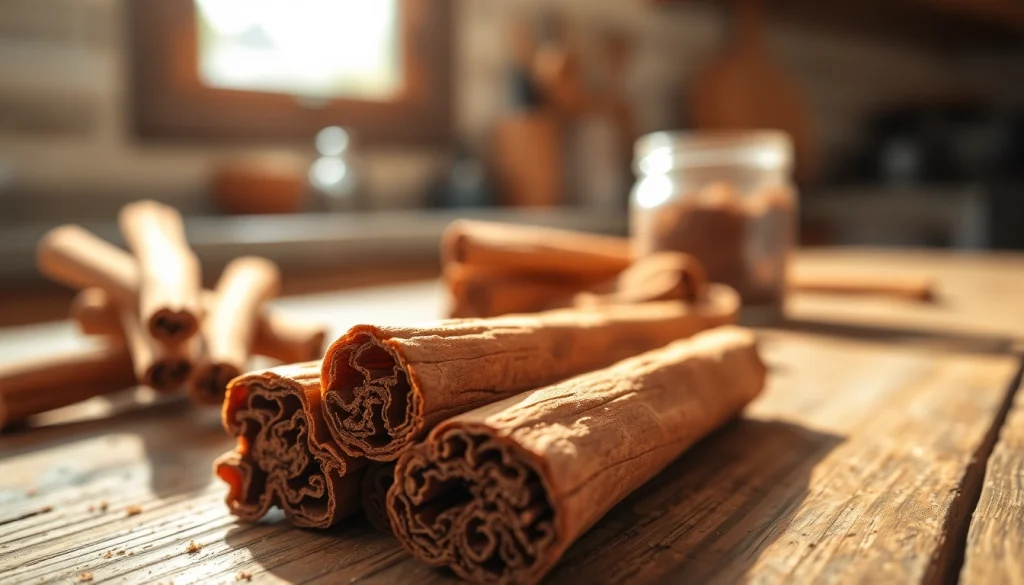
1. Understanding Cinnamon Bark: Origins and Properties
Cinnamon bark, derived from the inner bark of two main types of trees, has a rich history and numerous applications in culinary and medicinal practices. Understanding its origins, properties, and benefits can enhance how we use this remarkable spice in our daily lives. One imprinted spot in the spice trade and herbal medicine is the Cinnamon Bark, a versatile ingredient that can elevate both flavor and health.
1.1 Historical Uses of Cinnamon Bark
Cinnamon has adorned the pages of history for thousands of years. Its use can be traced back to ancient Egypt, where it was used in embalming and as a spice. The Romans valued it not only for its flavor enhancements but also for its medicinal properties. In traditional Chinese medicine, cinnamon bark, or “Rou Gui,” has been employed to promote circulation and warmth in the body. Throughout history, cinnamon has been regarded as a luxury item, often given as a gift among the elite and used in religious ceremonies.
1.2 Health Benefits of Cinnamon Bark
The health benefits of cinnamon bark are numerous and well-documented. It contains powerful antioxidants like polyphenols, compounds that help protect the body from oxidative damage. Cinnamon has been linked to improved heart health by lowering blood pressure, blood sugar levels, and reducing cholesterol. Furthermore, research suggests it may possess antimicrobial properties, making it beneficial for gut health. Studies indicate that cinnamon can help regulate insulin sensitivity, which is vital for individuals with type 2 diabetes.
1.3 Types of Cinnamon Bark: Ceylon vs. Cassia
Understanding the two primary types of cinnamon bark is crucial for selecting the right variety for your needs. Ceylon cinnamon, often referred to as “true cinnamon,” is characterized by its lighter color, subtle sweetness, and complex flavor profile. Cassia cinnamon, commonly found in stores, is darker, has a stronger flavor, and contains higher levels of coumarin, a compound that may be harmful in large quantities. The distinction affects not just taste but also potential health benefits, making it important to choose quality cinnamon based on intended use.
2. How to Select Quality Cinnamon Bark
Choosing the right cinnamon bark is pivotal for both flavor and health. Poor-quality cinnamon can compromise your recipes and may not provide the health benefits you seek. This section covers the key characteristics to look for when selecting cinnamon, how to source it responsibly, and tips for avoiding low-quality products.
2.1 Key Characteristics of Premium Cinnamon Bark
When seeking premium cinnamon bark, look for aromatic, warm scents that evoke the spice’s culinary heritage. Premium Ceylon cinnamon typically has a soft, crumbly texture, which is an indicator of its fine quality. Conversely, Cassia cinnamon is thicker and more challenging to break apart. Always assess the freshness; the more aromatic the bark, the fresher it is likely to be. Color is another indicator; Ceylon cinnamon features a light tan, while Cassia has a darker reddish-brown hue.
2.2 Where to Buy Authentic Cinnamon Bark
Purchasing authentic cinnamon can be a challenge due to the prevalence of counterfeit products in the market. Local organic grocery stores, specialty spice shops, and well-established online retailers often offer high-quality selections. Opt for sellers who can assure you of the product’s origin and quality. Pay attention to certifications that guarantee no synthetic additives or unhealthy preservatives.
2.3 Avoiding Low-Quality Cinnamon Bark Products
Be cautious of low-quality products, which may contain fillers or additives disguised as pure cinnamon. Always read labels meticulously and stay clear of products labeled simply as “cinnamon” without any specific type identification. If possible, ask sellers for information regarding how the cinnamon was sourced and processed. Remember, paying a bit more for quality can yield significant benefits in both health and flavor.
3. Innovative Ways to Use Cinnamon Bark in Cooking
Cinnamon bark can be creatively incorporated into various culinary applications. Its unique flavor profile elevates both sweet and savory dishes, as well as beverages, making it a versatile ingredient in any kitchen. Here, we explore innovative ways to incorporate cinnamon bark into your cooking.
3.1 Cinnamon Bark in Sweet Dishes
Sweet dishes often exhibit a wonderful harmony with the fragrant notes of cinnamon bark. Consider infusing cinnamon bark into your favorite desserts, such as apple pie, brownies, or oatmeal cookies. You can also use it to enhance the flavor of syrups and sauces, adding depth and complexity. For a delectable treat, steep cinnamon bark in warm milk and mix it into your favorite hot chocolate recipe or custard, imparting warmth and sweetness that delights the senses.
3.2 Incorporating Cinnamon Bark in Savory Recipes
Cinnamon isn’t just for desserts. Its warm, spicy notes can transform savory dishes as well. Add whole cinnamon bark to slow-cooked meats such as lamb or chicken. The bark releases its essential oils over time, enriching the overall flavor. Dishes like Moroccan tagines or Indian curries benefit immensely from cinnamon’s aromatic qualities. You may also incorporate it in rice pilafs or quinoa dishes to provide an unexpected twist that will amaze your guests.
3.3 Delicious Beverage Recipes Featuring Cinnamon Bark
Warm, soothing beverages featuring cinnamon bark can be a delightful addition to any season, especially during the colder months. Create chai tea by boiling cinnamon bark with black tea, ginger, and milk; the result is a rich and aromatic drink that warms the soul. Cinnamon-infused spirits can elevate cocktails; consider making spiced apple cider with simmered cinnamon bark and apple juice or preparing a cinnamon-infused bourbon for an elegant twist in your drinks menu.
4. Storing and Preserving Cinnamon Bark
Proper storage ensures that your cinnamon bark maintains its integrity and aromatic qualities. In this section, we explore the best practices for storing cinnamon, how to recognize signs of spoilage, and how long you can expect your cinnamon to last.
4.1 Best Practices for Cinnamon Bark Storage
To keep your cinnamon bark fresh, store it in an airtight container in a cool, dark place, away from direct sunlight and moisture. Exposure to light and humidity can diminish its flavor over time. If stored correctly, whole cinnamon sticks can last up to two years, while ground cinnamon may lose its potency within six months to a year. For home cooks, consider purchasing cinnamon in smaller quantities to ensure you use it while it’s still fresh.
4.2 Signs of Spoilage in Cinnamon Bark
While cinnamon has a long shelf life, it’s essential to check for signs of spoilage. If you notice a drastic change in aroma—becoming weak or musty—this is a signal that the cinnamon is no longer fresh. Additionally, look for changes in color and texture; whole bark should remain firm and not brittle, while ground cinnamon should maintain its rich, distinct hue without clumping.
4.3 How Long Does Cinnamon Bark Last?
Whole cinnamon bark can last up to two to three years when stored properly, while ground cinnamon typically lasts one to two years. However, for the best flavor and health benefits, it is advisable to purchase spices in smaller amounts. It’s worth noting that spices tend to lose their potency over time; frequently replacing them ensures you get maximum flavor and benefits in your culinary endeavors.
5. The Role of Cinnamon Bark in Holistic Health
Cinnamon bark is far from just a culinary delight; it plays an essential role in holistic health practices. This section delves into the various ways cinnamon can be utilized in herbal supplements, its anti-inflammatory properties, and tips for integrating it into a balanced diet.
5.1 Using Cinnamon Bark in Herbal Remedies
Cinnamon bark has long been a staple in herbal remedies. It can be used to brew a soothing tea known for its cardiovascular benefits, which helps manage blood sugar levels. To create an herbal remedy, steep 1-2 sticks of cinnamon bark in boiling water for about 15 minutes, adding honey or lemon for flavor. This tea not only tastes great but can support your overall well-being, offering antimicrobial and antioxidant benefits.
5.2 Cinnamon Bark as a Natural Anti-inflammatory
Inflammation is at the root of many chronic conditions. Cinnamon bark’s anti-inflammatory properties can significantly support overall health. Compounds found in the bark, such as cinnamaldehyde, have been shown to reduce inflammation in the body. Incorporating cinnamon into a diet can help alleviate conditions such as arthritis or cardiovascular diseases, promoting long-term well-being.
5.3 Integrating Cinnamon Bark into a Balanced Diet
Incorporating cinnamon bark into a balanced diet can be straightforward and beneficial. You can sprinkle it on your morning oatmeal or mix it into smoothies for added flavor and nutrients. Try using cinnamon during dish preparation, adding it to roasted vegetables or marinades for an earthy, warm flavor. The key is moderation—while cinnamon is healthy, it’s best consumed as part of a diverse and balanced diet.






